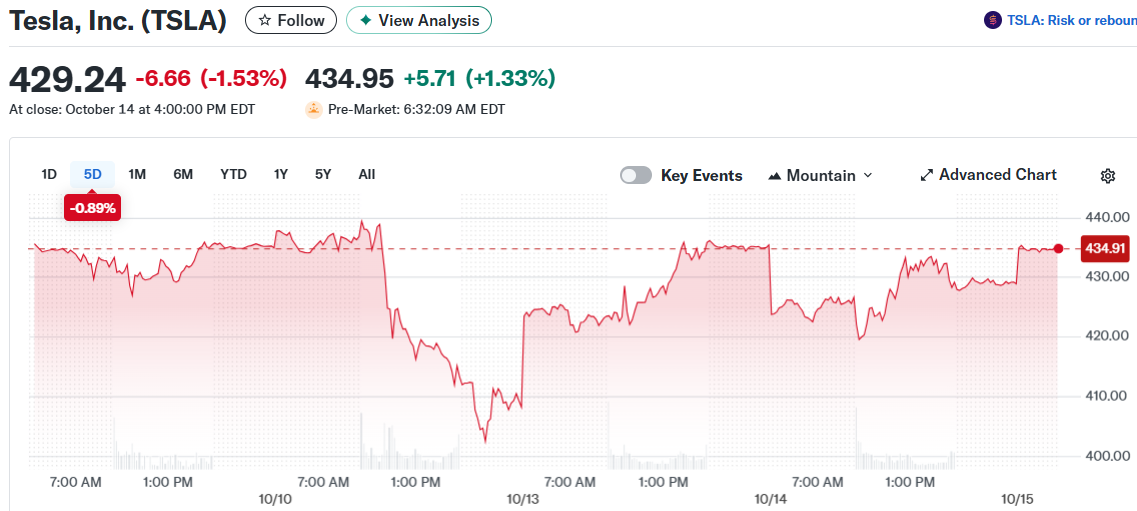TLDR
- Tesla sold 71,525 vehicles in China during September 2025, its second-best monthly performance this year behind March’s 74,127 units.
- Global Q3 deliveries reached 497,099 units, up 7% year-over-year, potentially driven by U.S. buyers claiming the $7,500 EV tax credit before its September 30 expiration.
- Model Y outsold Model 3 in China with 59,907 wholesale units versus 30,905, showing a 17.1% year-over-year gain while Model 3 dropped 16.8%.
- Tesla China recorded its seventh consecutive month of year-over-year decline, down 0.93% in September despite strong monthly growth of 25% from August.
- The stock’s P/E ratio stands at 239, making it seven times pricier than the Nasdaq-100 as investors focus on future products like Cybercab and Optimus robot.
Tesla posted 71,525 retail sales in China for September, according to China Passenger Car Association data. The result marks the company’s second-strongest month in 2025.

September’s performance represents a 25% jump from August. However, Tesla has now recorded year-over-year declines for seven straight months in its second-largest market.
The company’s Shanghai factory exported 19,287 vehicles in September, up 19.6% year-over-year but down 25.9% from August. Total wholesale volume from the facility reached 90,812 units.
China Market Performance
Model Y led Tesla’s Chinese sales with 59,907 wholesale units, climbing 17.1% year-over-year. Model 3 reached 30,905 units, falling 16.8% compared to last year but rising 27% from August.
Tesla’s market share in China’s new energy vehicle segment increased to 5.52%. Its battery electric vehicle share climbed to 8.66%.
For Q3 2025, Tesla sold 169,294 vehicles in China, down 6.9% year-over-year. This marks the second consecutive quarterly decline.
The quarter still showed a 31.4% recovery versus Q2. Year-to-date retail sales total 432,704 units, down 5.97% from 2024.
Global Delivery Growth Raises Questions
Tesla delivered 497,099 EVs worldwide in Q3. The 7% year-over-year increase reversed a pattern of declining sales that plagued the first half of 2025.
Analysts believe U.S. sales drove most of the growth. American consumers rushed to purchase EVs before the $7,500 government tax credit expired on September 30.
Tesla commands a 43.1% market share in the U.S., far exceeding General Motors at 13.8%. The expiration likely created a one-time surge in demand.
This timing could hurt Q4 performance. Sales may have shifted forward from later in the year.
Tesla delivered 1.79 million EVs in 2024, down 1% from the previous year. First-half 2025 deliveries dropped 13% to 720,803 units.
Stock Valuation and Future Products
Tesla shares have surged 90% over the past year. The rally pushed the stock’s P/E ratio to 239.
This makes Tesla seven times more expensive than the Nasdaq-100’s 33.5 P/E ratio. The stock is also the priciest in the Magnificent Seven group.
Tesla’s valuation is nearly five times higher than Nvidia’s. Investors are betting on future products rather than current automotive performance.
The company reports full Q3 earnings on October 22. CEO Elon Musk will likely discuss the Cybercab robotaxi and Optimus humanoid robot.
Cybercab is scheduled for mass production in 2026. The robotaxi depends on regulatory approval for Tesla’s full self-driving software.
Musk wants approval in some states before year-end. Optimus production targets sit around 2030, making it years away from commercialization.
Tesla’s Q3 global deliveries totaled 497,099 vehicles, representing a 7% increase year-over-year.


